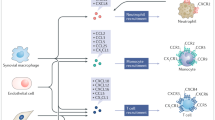Abstract
One of the main reasons for interest in chemokines is the ease with which their expression can be documented in physiological settings involving leukocyte trafficking or in diseases characterized by inflammatory cell infiltration. In the case of most ELR-containing CXC chemokines, their ability to attract neutrophils in vitro is paralleled by a similar activity when injected In vivo (1–3). However, in the case of non-ELR CXC and most CC chemokines, injection In vivo has resulted in disparate and inconsistent reports of activity (4–6). Thus, in order to be able to infer anything about the function of chemokines in normal physiology or disease, it must be demonstrated that their in vitro activities accurately predict their In vivo activities.
Access this chapter
Tax calculation will be finalised at checkout
Purchases are for personal use only
Similar content being viewed by others
References
Colditz I., Zwahlen R., Dewald B., and Baggiolini M. (1989) In vivo inflammatory activity of neutrophil-activating factor, a novel chemotactic peptide derived from human monocytes. Am. J. Pathol. 134, 755–760.
Foster S. J., Aked D. M., Schroder J. M., and Christophers E. (1989) Acute inflammatory effects of a monocyte-derived neutrophil-activating peptide in rabbit skin. Immunology 67, 181–183.
Larsen C. G., Anderson A. O., Oppenheim J. J., and Matsushima K. (1989) Production of interleukin 8 by human dermal fibroblasts and keratinocytesin response to interleukin 1 or tumor necrosis factor. Immunology 68, 31–36.
Van Damme J., Proost P., Lenaerts J. P., and Opdenakker G. (1992) Structural and functional identification of two human, tumor-derived monocyte chemotactic proteins (MCP-2 and MCP-3) belonging to the chemokine family. J. Exp. Med. 176, 59–65.
Zachariae C. O. C., Anderson A. O., Thompson H. L., Appella E., Mantovani A., Oppenheim J. J., and Matsushima K. (1990) Properties of monocyte chemo-tactic and activating factor (MCAF) purified from a human fibrosarcoma cell line. J. Exp. Med. 171, 2177–2182.
Rutledge B. J., Rayburn H., Rosenberg R., North R. J., Gladue R. P., Corless C. L., and Rollins B. J. (1995) High level monocyte chemoattractant protein-1 expression in transgenic mice increases their susceptibility to intracellular patho-gens. J. Immunol. 155, 4838–4843.
Cook D. N., Beck M. A., Coffman T. M., Kirby S. L., Sheridan J. F., Pragnell I. B., and Smithies O. (1995) Requirement of MIP-1 alpha for an inflammatory response to viral infection. Science 269, 1583–1585.
Lu B., Rutledge B. J., Gu L., Fiorillo J., Lukacs N. W., Kunkel S. L., et al. (1998) Abnormalities in monocyte recruitment and cytokine expression in mono-cyte chemoattractant protein 1-deficient mice. J. Exp. Med. 187, 601–608.
Simonet W. S., Hughes T. M., Nguyen H. Q., Trebasky L. D., Danilenko D. M., and Medlock E. S. (1994) Long-term impairment of neutrophil migration in mice overexpressing human interleukin-8. J. Clin. Invest 94, 1310–1319.
Lira S. A., Zalamea P., Heinrich J. N., Funetes M. E., Carrasco D., Lewin A. C., et al. (1994) Expression of the chemokine N51/KC in the thymus and epidermis of transgenic mice results in a marked infiltration of a single class of inflammatory cells. J. Exp. Med. 180, 2039–2048.
Fuentes M. E., Durham S. K., Swerdel M. R., Lewin A. C., Barton D. S., Megill J. R., et al. (1995) Controlled recruitment of monocytes/macrophages to specific organs through transgenic expression of MCP-1. J. Immunol. 155, 5769–5776.
Nakamura K., Williams I. R., and Kupper T. S. (1995) Keratinocyte-derived monocyte chemoattractant protein 1 (MCP-1): analysis in a transgenic model dem-onstrates MCP-1 can recruit dendritic and Langerhans cells to skin. J. Invest. Dermatol. 105, 635–643.
Tani M., Fuentes M. E., Peterson J. W., Trapp B. D., Durham S. K., Loy J. K., et al. (1996) Neutrophil infiltration, glial reaction, and neurological disease in ransgenic mice expressing the chemokine N51/KC in oligodendrocytes. J. Clin. Invest. 98, 529–539.
Gunn M. D., Nelken N. A., Liao X., and Williams L. T. (1997) Monocyte chemoattractant protein-1 is sufficient for the chemotaxis of monocytes and lymphocytes in transgenic mice but requires an additional stimulus for inflammatory activation. J. Immunol. 158, 376–383.
Grewal I. S., Rutledge B. J., Fiorillo J. A., Gu L., Gladue R. P., Flavell R. A., and Rollins B. J. (1997) Transgenic monocyte chemoattractant protein-1 (MCP-1) in pancreatic islets produces monocyte-rich insulitis without diabetes: abrogation by a second transgene expressing systemic MCP-1. J. Immunol. 159, 401–408.
Hogan B., Costantini F., and Lacy E. (1986) Manipulating the Mouse Embryo: A Laboratory Manual. Cold Spring Harbor Laboratory Cold Spring Harbor, NY.
Laird P. W., Zijderveld A., Linders K., Rudnicki M. A., Jaenisch R., and Berns A. (1991) Simplified mammalian DNA isolation procedure. Nucleic Acids Res. 19, 4293.
Chirgwin J. M., Przybyla A. E., MacDonald R. J., and Rutter W. J. (1979) Isolation of biologically active ribonucleic acid from sources enriched in ribonuclease. Biochemistry 18, 5294–5299.
Taketo M., Schroeder A. C., Mobraaten L. E., Gunning K. B., Hanten G., Fox R. R., et al. (1991) FVB/N: an inbred mouse strain preferable for transgenic analyses. Proc. Natl. Acad. Sci. USA 88, 2065–2069.
Author information
Authors and Affiliations
Editor information
Editors and Affiliations
Rights and permissions
Copyright information
© 2000 Humana Press Inc.
About this protocol
Cite this protocol
Grewal, I., Gu, L., Tseng, S., Rollins, B.J. (2000). Targeted Expression of Chemokines In vivo . In: Proudfoot, A.E.I., Wells, T.N.C., Power, C.A. (eds) Chemokine Protocols. Methods in Molecular Biology, vol 138. Humana Press. https://doi.org/10.1385/1-59259-058-6:243
Download citation
DOI: https://doi.org/10.1385/1-59259-058-6:243
Publisher Name: Humana Press
Print ISBN: 978-0-89603-722-9
Online ISBN: 978-1-59259-058-2
eBook Packages: Springer Protocols




